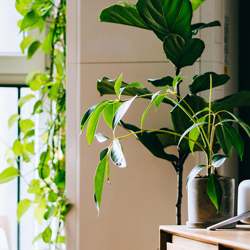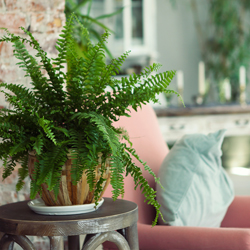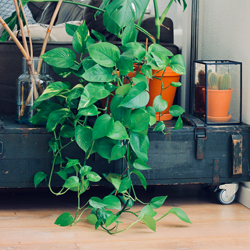The benefits of houseplants are well known: they help eliminate odors and freshen the air, reduce stress, boost productivity, improve humidity, and lower background noise. But you won’t get the full positive effects of your houseplants if you aren’t very deliberate and thoughtful about where you position each plant. In the right spot, you can enjoy even more benefits from every plant in your home.
Positioning Houseplants for Their Benefit
To get the most from your houseplants, it is important to position each plant so it can reach its full growth potential. A healthy plant will have lush foliage, rich color, and beautiful blooms, and the proper position will help keep each plant healthy. When considering where to place each plant, give careful thought to…
- Light – Every houseplant needs proper sunlight exposure, but not all plants require the same amount or type of light. Some plants thrive in direct sunlight, while others need indirect, filtered light to avoid burning. Consider the number of hours each plant will receive in each location, bearing in mind how sun exposure changes in different seasons.
- Temperature – Most houseplants are chosen because they can grow well in typical household temperatures, but keep in mind how you like the temperature in your home. If you prefer a warmer or colder home, you may need to choose houseplants that will grow best in those temperatures. Also factor in potential drafts, warmth, or chills from nearby windows and doors.
- Humidity – Most homes have very low humidity, which can be traumatic for plants. Positioning houseplants in rooms that are naturally more humid, such as the bathroom or kitchen, can help them stay healthy and vibrant. Rooms where you spend a lot of time will also have higher humidity thanks to your own breath, and the plants will happily breathe along with you.
- Air Circulation – All plants need proper air circulation to stay healthy and minimize pests, but unfortunately most homes have very still, stagnant air. Placing a houseplant in an area with gentle breezes, such as a spot where you pass nearby often to disturb the air, a room with a ceiling fan that is used frequently, or where a window is often open, will help keep the plant happier and healthier.
Positioning Houseplants for Your Benefit
Even a lush, healthy houseplant that is in the ideal place for its growth and beauty won’t give you nearly as many benefits if you rarely see or enjoy the plant. Once you’ve chosen a location for your houseplant’s best health, also consider…
- Busy Rooms – The rooms where you spend the most time are the locations where you will enjoy your plant the most, noticing even small changes in its foliage, size, and blooms. These are also the locations where you will get the most benefits from fresher air and the other traits that make houseplants so desirable.
- Viewpoint – You aren’t as likely to notice a houseplant if you have it tucked into a corner or otherwise out of the way, even in a busy room. Instead, use the plants to create a meaningful focal point in the room, or position even a small plant within your common field of view, such as on the windowsill of a favorite window or on the corner of your desk.
- Activities – Choose houseplants that coordinate with the functions of the rooms they will live in. Growing herbs in the kitchen, however, will draw your attention and invite you to enjoy their fresh taste in your favorite recipes. Aloe for healing in the bathroom, bold palms in an active family room, and hardy snakeplants in the bedroom are other popular choices.
- Attention-Grabbing Accents – Another way to ensure you are able to better notice plants is to be sure they stand out and catch your attention. Instead of using neutral, camouflaged pots, opt for bold bursts of color that add energy to the room. Choose houseplants with unusual shapes or unique colors to add their own distinction to the rooms they inhabit.
- Interior Landscaping – Houseplants are often treated as simple decorative accents, but they can be so much more. Be aware of your plant’s habits and allow it to grow and thrive naturally, such as allowing a pothos to climb and wend its way over a bookshelf instead of limiting it with pruning. Group plants together to form interior landscapes that draw even more attention.
- Pay Attention – You won’t derive many benefits from your houseplants if you don’t pay attention to them. Take the time to focus on the plant, noting its new growth, shed leaves, soil condition, leaf texture, and other characteristics. Not only will this allow you to care for the plant more effectively, but you’ll increase your own focus and awareness simultaneously.
Houseplants can provide us with a variety of amazing benefits, but if your plants aren’t in the best position, they will not thrive and you will not receive the full effects they can provide. By understanding the plants’ location needs and how to make those locations work for you as well, you can ensure the maximum enjoyment and refreshment from every plant in your home.



